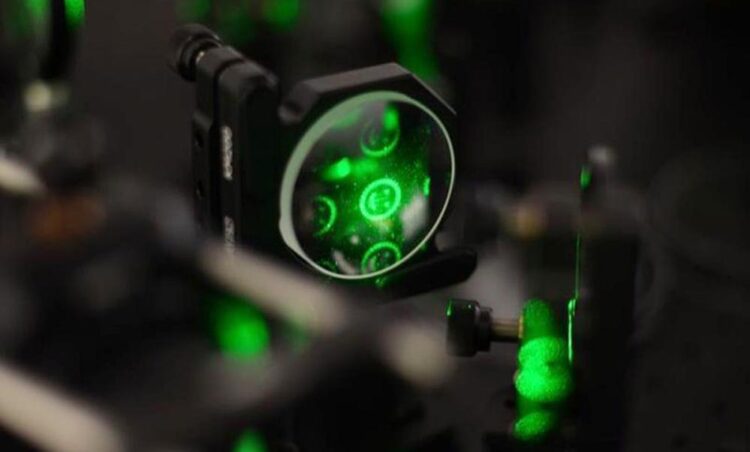Swarm Intelligence Caused by Physical Mechanisms

The photo shows the laser optics used in the experiment for coordinating schools of synthetic Brownian microswimmers.
Photo: Xiangzun Wang
Seemingly spontaneously coordinated swarm behaviour exhibited by large groups of animals is a fascinating and striking collective phenomenon. Experiments conducted by researchers at Leipzig University on laser-controlled synthetic microswimmers now show that supposed swarm intelligence can sometimes also be the result of simple and generic physical mechanisms. A team of physicists led by Professor Frank Cichos and Professor Klaus Kroy found that swarms of synthetically produced Brownian microswimmers appear to spontaneously decide to orbit their target point instead of heading for it directly. They have just published their findings in the renowned journal Nature Communications.
“Scientific research on herd and flock behaviour is usually based on field observations. In such cases, it is usually difficult to reliably record the internal states of the herd animals,” Kroy said. As a result, the interpretation of observations frequently relies on plausible assumptions as to which individual behavioural rules are necessary for the complex collective groups under observation. Researchers at Leipzig University therefore developed an experimental model system of microswimmers that elicits properties of natural swarm intelligence and provides complete control over the individuals’ internal states, strategies, and transformation of signal perception into a navigational reaction.
Thanks to a sophisticated laser heating system (see image), the colloidal swimmers, which are visible only under the microscope, can actively self-propel in a water container by a kind of “thermophoretic self-propulsion” while their travel is permanently disturbed in a random manner by Brownian motion. “Apart from Brownian random motion, which is ubiquitous in microphysics, the experimental set-up provides complete control over the physical parameters and navigation rules of the individual colloidal swimmers and allows long-term observations of swarms of variable sizes,” Cichos said.
According to Cichos, when just a very simple and generic navigation rule is followed identically by all of the swimmers, a surprisingly complex swarm behaviour results. For example, if the swimmers are aiming at the same fixed point, instead of them gathering at the same place a kind of carousel can form. Similar to satellites or atomic electrons, the swimmers then orbit their attractive centre on circular paths of varying heights. The only “intelligent” behavioural rule required for this is that the self-propulsion responds to environmental perception with a certain time delay, which usually occurs in natural swarm phenomena from mosquito dances to road traffic anyway. It turns out that such a “delayed” effect alone is sufficient to form complex dynamic patterns such as the carousel described above. “Physically speaking, each individual swimmer can spontaneously break the radial symmetry of the system and go into circular motion if the product of the delayed time and swimming speed is large enough,” Kroy said. In contrast, the orbits of larger swarms and their synchronisation and stabilisation depend on additional details such as the steric, phoretic and hydrodynamic interactions between the individual swimmers.
Since all signal-response interactions in the living world occur in a time-delayed manner, these findings should also further the understanding of dynamic pattern formation in natural swarm ensembles. The researchers deliberately chose primitive and uniform navigation rules for their experiment. This allowed them to develop a stringent mathematical description of the observed phenomena. In the analysis of the delayed stochastic differential equations used for this purpose, the delay-induced effective synchronisation of the swimmers with their own past turned out to be the key mechanism for the spontaneous circular motion. To a large extent, the theory allows us to mathematically predict the experimental observations. “All in all, we have succeeded in creating a laboratory for swarms of Brownian microswimmers. This can serve as a building block for future systematic studies of increasingly complex and possibly still unknown swarm behaviour, and it may also explain why puppies often circle their food bowl when they are being fed,” Cichos said.
Wissenschaftliche Ansprechpartner:
Prof. Dr. Klaus Kroy
Phone: +49 341 97-32436
EMail: klaus.kroy@uni-leipzig.de
Prof. Dr. Frank Cichos
Phone: +49 341 97-32571
EMail: cichos@physik.uni-leipzig.de
Originalpublikation:
“Spontaneous vortex formation by microswimmers with retarded attractions”, doi.org/10.1038/s41467-022-35427-7
https://www.nature.com/articles/s41467-022-35427-7
Media Contact
All latest news from the category: Physics and Astronomy
This area deals with the fundamental laws and building blocks of nature and how they interact, the properties and the behavior of matter, and research into space and time and their structures.
innovations-report provides in-depth reports and articles on subjects such as astrophysics, laser technologies, nuclear, quantum, particle and solid-state physics, nanotechnologies, planetary research and findings (Mars, Venus) and developments related to the Hubble Telescope.
Newest articles

Properties of new materials for microchips
… can now be measured well. Reseachers of Delft University of Technology demonstrated measuring performance properties of ultrathin silicon membranes. Making ever smaller and more powerful chips requires new ultrathin…

Floating solar’s potential
… to support sustainable development by addressing climate, water, and energy goals holistically. A new study published this week in Nature Energy raises the potential for floating solar photovoltaics (FPV)…

Skyrmions move at record speeds
… a step towards the computing of the future. An international research team led by scientists from the CNRS1 has discovered that the magnetic nanobubbles2 known as skyrmions can be…





















